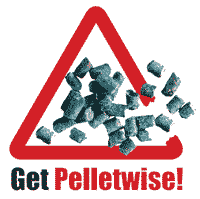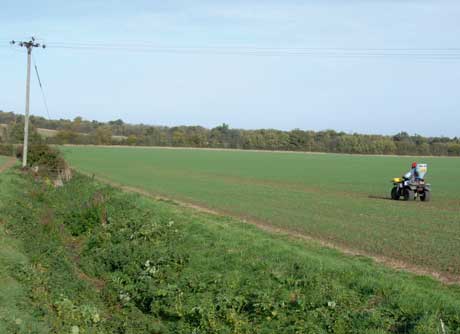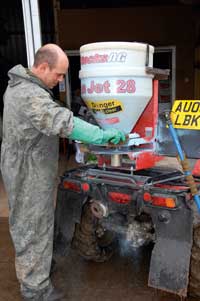Get Pelletwise: Guidelines aim to keep metaldehyde

Keeping metaldehyde in the slug control armoury is a job for everyone. Charles Abel examines guidelines designed to help growers achieve just that
A third of wheat crops and two-thirds of oilseed rape crops typically receive slug pellets, with metaldehyde dominating the market. To prevent severe restrictions on this key arable input growers need to improve pellet use and improve it fast.
That is why the Metaldehyde Stewardship Group is advocating significantly lower application rates, more effort to protect field margins and an end to spreading when rain is forecast.
| GUIDELINES FOR PELLET USE |
|---|
| 5m no-pellet buffer around all water courses and ditches Keep pellets out of field margins; switch off when turning; treat headland last Don’t pellet if heavy rain is forecast or leaching and/or run-off likely 700g/ha max per season; 250g/ha max per application; adjust rate to pellet size Treat according to need, use trapping Fill in field, clear up spills, never leave product unattended Clean applicator in field away from ditch and road Store kit under cover; dispose of waste appropriately Calibrate applicator for rate and side/rear spread Pellets are pesticides; users must be trained; use protective clothing MSG members: Lonza, Frunol Delicia, Certis, Chiltern Farm Chemicals, De Sangosse, Doff Portland, SBM, Makhteshim Agan |

“Slugs are the biggest pest problem in the UK, but if metaldehyde residues in water don’t reduce significantly this autumn some very severe restrictions could be imposed,” warns East Anglian agronomist Colin Myram. “That could have disastrous consequences on arable farming operations.”
The trouble is that even a little metaldehyde in the wrong place can be an issue. Just two or three pellets falling in a ditch can push residue levels in a 100m stretch of ditch water above the EU limit for use as drinking water.
Water companies, the Environment Agency, the Pesticides Safety Directorate and DEFRA all want big reductions in residues this autumn. To help growers achieve that, and stave off restrictions, the MSG has drawn up guidelines to tackle point source, diffuse and direct sources of pollution. Based on extensive industry consultation they also have the full support of Bayer, which markets slug pellets containing methiocarb.
Importantly, there is no conflict with profitable cropping, Mr Myram insists. “Nobody wants to put pellets where they won’t do their intended job, or use inappropriate rates, so it all ties in with crop profits. And that’s not to mention saving the considerable grief and impact on crop profits if metaldehyde use were restricted.”
Margins

So what needs changing? Filling, cleaning, calibration and applicator use all need attention. There are some big changes to recommended rates too. But the biggest focus is preventing pellets from getting into water through inappropriate applications into field margins.
An MSG survey (PDF) earlier this year showed 43% of pellet users wrongly thought field margins needed treating, because they were a significant source of slugs. “That is something we can really get to work on,” says Mr Myram.
“Why do growers think slugs come from field margins? Is it because they see the big black slugs emerging from there? They’re not the biggest threat. It’s the 100 hungry juvenile slugs emerging from eggs laid by each small grey field slug in the body of the field that are the real headache.”
Independent slug specialist Prof David Glen of Styloma Consulting agrees. “Field margins are just not important in winter wheat and even in oilseed rape, where black slugs may have an impact. The focus should be on treating the edge of the crop, not the field margin.”
| SOURCES OF CONTAMINATION |
|---|
Point source Direct application: Diffuse |
MSG advice is unequivocal. All product labels should now carry the stewardship phrase: “Ensure pellets do not fall within 5m of a watercourse or ditch”. That means no pellets on the 2m cross-compliance strip beside watercourses of ditches and no pellets on the first 3m of crop either, notes Mr Myram.
“Growers might have to sacrifice 3m of crop if they want to preserve metaldehyde for the future. It really is that important.”
Forecasting
Timing of applications is critical, get it wrong and crops can be lost. However, pellets should not be applied if heavy rain is forecast, or leaching and run-off is likely, especially on heavy clay soils. Better use of five-day weather forecasting was found to be a real boon in catchment sensitive areas of the Voluntary Initiative.
| METALDEHYDE PELLETS |
|---|
6-10,000t of slug pellets applied/year |
Rates
The stewardship group also advocates lower rates. This is advisory nowt could become statutory, once efficacy issues have been addressed with the PSD.
The maximum should be 700g/ha of active ingredient per season, significantly lower than current label rates, which permit up to 900g/ha for each application and no limit on the number of applications in a season.
A maximum of 250g/ha of active ingredient for each individual application is also advocated. That equates to 5kg/ha of a 5% product, 6kg of a 4% product, 8kg for 3% and 15kg for 1.5%. Rates should also be adjusted to pellet size – recognised optimum number of pellets per sqm is 40 – some products achieve this at 3kg/ha, others at 7.5kg/ha
Overalls
More than half of operators surveyed by the MSG wore normal clothing or overalls when applying pellets, raising the risk of residues entering water supplies through the washing machine. “If you apply an insecticide by ATV you wear the right protective clothing and dispose of it or clean it appropriately. The same should apply for slug pelleting,” Mr Myram advises.
Endgame
The final word on the guidelines goes to MSG chairman David Cameron. “Detections of metaldehyde must be reduced and we can all make a difference. We can all ensure best practice. So get Pelletwise before it is too late.”
Farmers Weekly, Crops and FWi are supporting the “Get Pelletwise” initiative with a series of articles, academies, posters and forums over the coming months. In May our focus shifts to the impact restrictions could have. Find out more at www.getpelletwise.co.uk and www.fwi.co.uk/getpelletwise, where you’ll find all the key pelletwise information and articles.

